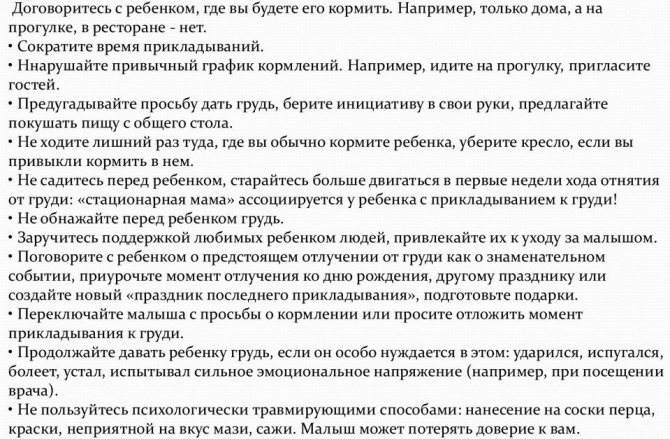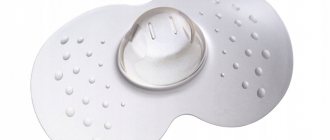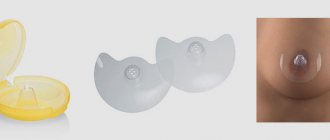No matter how long breastfeeding lasts, there comes a time when the mother decides to complete this important process of feeding the child. It would be easy and simple if the child himself refused the breast or the milk ran out; in practice, such examples occur, but most often the process of ending breastfeeding is not so simple.
Previously, our grandmothers and mothers ended breastfeeding (BF) in an unsafe way, which brought not only pain, but also negative consequences for the woman’s health. In this article we will offer only the right recommendations and advice.
When is it time to stop breastfeeding?
Only the nursing mother herself knows the exact answer to this question. It is her psychological readiness and desire that determines the completion date of feeding. If a mother wants to feed an older baby (who has already fully mastered the adult diet), then you should not give in to the opinion of relatives, friends and acquaintances who say that the older the child is, the more difficult it is to wean him. You can often hear from others that milk after a year is already water, that it has lost its benefits, but this is far from the case. After a year of breastfeeding, the fat content of breast milk only increases as feedings become less frequent. Milk remains a valuable source of proteins, fats and enzymes; it retains hormones, vitamins and microelements, which are quickly and easily absorbed.
It contains more antibodies, and the content of immunoglobulin A increases, which protects the mucous membranes of the mouth, intestines and stomach from pathogenic microorganisms. It is also worth considering that breastfeeding forms a psychological attachment between mother and baby, the child calms down faster and relieves his stress. In the future, the neuropsychic development of children will differ for the better from children who were not on breastfeeding. It has been noted that breastfed children adapt better into adulthood.
In addition, research has shown that:
- Children who were breastfed from 12 to 23 months had a 28% lower risk of being overweight at age 4.
- Each additional year of breastfeeding reduces a child's chance of developing type 2 diabetes by 9%.
- Breastfeeding for more than 12 months reduces the risk of breast cancer in a nursing mother by 26%.
- Breastfeeding reduces the risk of ovarian cancer by 37%.
- We talked about other benefits of breast milk and feeding rules in this article.
Thus, breast milk provides greater immune support to the baby’s body; it contributes to the development of the child’s own immune system and the preservation of the mother’s health.
From a medical point of view, WHO recently recommended continuing breastfeeding for up to two years. But already in December 2021, WHO released an article in which it recommends continuing breastfeeding after 2 years. However, if breastfeeding causes discomfort, pain and irritation (babies over one year old like to bite, pull or simply play with the nipple), then continuing to breastfeed will not bring much benefit for both mother and baby. In addition, in modern realities, long-term feeding is not always possible, therefore, most often, breastfeeding ends already at 1 or 2 years of a child’s life.
Medical cessation of breast milk lactation
Drugs that stop breast lactation are very popular as the easiest way to reduce milk production. But it is worth knowing that drugs that are part of the group of dopaminomimetics (suppressing lactation) have a bad reputation and are banned in many countries. Very often, after studying the instructions for such drugs, nursing mothers decide to complete breastfeeding naturally and are interested in information on how to stop lactation without pills.
In what cases is the use of medications to reduce lactation necessary? There are 4 main situations:
- Deterioration of the mother's health due to breastfeeding - purulent mastitis, lactostasis, elevated temperature, coupled with inflammation in the chest - are often recurrent in nature and can lead to surgical intervention. As prescribed by the doctor, feeding in this case is stopped with the help of selected medications to restore the woman’s health;
- Serious illnesses during pregnancy (tuberculosis, HIV infection, etc.) can lead to weaning immediately after birth and taking medications to curtail lactation;
- The presence of cancer in the mother is also an indication for stopping breastfeeding with medication, if radiation and/or chemotherapy is carried out;
- The birth ended in the death of the newborn - the goal is to suppress milk production, and for this purpose pills are used to reduce prolactin and end lactation, which is unnecessary in this situation.
Remember that suppressing lactation with the help of pills is a strong stress for the body. Before resorting to an emergency method, weigh the pros and cons - the triggered mechanism for stopping breastfeeding cannot be reversed. The decision to end breastfeeding in this manner must be made carefully and with good reason.
| Medicine | Operating principle |
| Dostinex | One of the most popular remedies for mothers who want to stop lactation quickly and without unnecessary hassle. It is available in tablet form and is taken for only two days (rarely – up to 7-8 days). + the level of the milk production hormone decreases in the first three hours after taking the drug + the effect of the medicine lasts up to 2 weeks, which allows the milk to “burn out” and its release will stop + has a minimum of side effects compared to analogues – high price (from 700 rub.) |
| Agalathes | Suppresses both physiological postpartum lactation and already established ones, but only according to honey. indications. Release form: tablets. + well reduces prolactin levels in blood plasma + relatively low price (from 350 rub.) – side effects are common (nausea, headaches, breast tenderness) – periodically after taking the drug, colostrum continues to be released |
| Bromocreptine | It has a wide spectrum of action; in addition to suppressing prolactin, it is used for menstrual irregularities. It is taken in a long course of 14-21 days. Available in tablets. + when taken conscientiously and regularly, promotes gentle cessation of breastfeeding + low cost of the drug (from 250 rubles) – has a number of contraindications – long course of medication |
Important! Pills to stop lactation have many side effects and contraindications that cannot be ignored. If you think you need medication to stop breastfeeding, talk to your gynecologist about this.
After studying the basic methods, we recommend watching a video about the rules for stopping lactation from a breastfeeding consultant:
What are the dangers of incorrect termination of breastfeeding?

Nowadays, on many sources of information you can find articles that recommend completing breastfeeding by tightly pulling the chest with a diaper. It is advised to tighten the diaper or scarf as tightly as possible and walk for several days without removing the bandage . This harsh method is passed down from generation to generation. Many women experience stabbing, aching and sharp pain, since this method does not greatly reduce the flow of milk, and burnt milk leads to the appearance of lumps, enlargement and stoniness of the breast. Often, the consequences of this method of completing breastfeeding are the appearance of inflammation, lactostasis, cysts, mastitis, purulent abscess and mastopathy. The fact is that lactation is a hormonal process, and squeezing the breast will not make the milk go away.
Another situation is if there is an urgent need to stop breastfeeding, for example, mother’s illness or long-term departure from home. In this case, a modern, popular, but not safe way to stop lactation comes to the rescue - taking hormonal medications. Many mothers find information on the Internet with the names of pills that will help quickly stop milk production, not realizing that they are prohibited for use in many countries due to side effects. Most often, such drugs are prescribed in the first days of a child’s birth, if there is no need for breast milk. If you decide to wean your child after prolonged feeding, then the doctor can prescribe it only in case of urgent need , for example, the mother is ill or the child suddenly refuses to breastfeed, i.e. when there was no smooth (soft) preparation for the completion of breastfeeding.
If you decide to take the drug yourself without consulting a doctor, keep in mind that, for example, the drug Bromocriptine has the following contraindications: diseases of the cardiovascular system, arterial hypotension or hypertension, diseases of the heart valves, liver failure. Anti-lactation pills are a gross interference in mommy’s hormonal system!
According to mothers, the drug is difficult to tolerate: general malaise, fever and chills, nausea, vomiting, dizziness, darkening of the eyes, lethargy, decreased blood pressure, dry mouth, constipation, abdominal pain and even loss of consciousness appear. In some cases, milk reappears 2-3 days after stopping taking the pills.
Important!
The drug Bromocriptine (Parlodel, Bromolactin, Krypton) has been withdrawn from use in several countries due to the risk of myocardial infarction, high or low blood pressure, convulsions or seizures!
Another drug, Dostinex, also has contraindications: cardiac and respiratory dysfunction, arterial hypertension, peptic ulcer, gastrointestinal bleeding; severe liver failure, etc. According to reviews, the drug is better tolerated than Bromocriptine, but there are also unpleasant side effects: dizziness, decreased blood pressure, drowsiness, weakness, nausea, stomach pain, rapid heartbeat, etc.
Another disadvantage of hormonal drugs is that their active substances end up in milk, so you can no longer offer the breast to the baby, even if the breast is full. Therefore, you only need to express your breasts until relief occurs. We also note the high cost of this product, about 1000 rubles for 2 tablets.
Please note: lactation consultants and international organizations do not recommend hormonal drugs when weaning a baby!
Basic weaning methods
Remember, the main principle if you want to complete natural feeding is “do no harm.” Every mother needs to know how to stop breast milk lactation correctly to avoid negative consequences. You can move painlessly to the next stage of feeding your baby only by choosing the key method of interrupting breastfeeding and sticking to it.
| Way | Key points |
| Natural | The method is step-by-step and is used after 6 months of the baby’s life (with the start of complementary feeding). The baby learns to eat something other than breast milk; then the consumption of new food begins to predominate, and breast sucking fades into the background. Feedings come to naught, and sooner or later they exhaust themselves. This is a process stretched over several months. |
| Gradual | One of the most effective ways to stop breastfeeding. Feedings are removed slowly, the breasts gradually and without stress stop producing milk. The period of excommunication is indefinite and has no specific framework. |
| Cutting | The most unpleasant and harsh method of stopping lactation (often medication). From the beginning to the end of weaning the baby from the breast, 1-3 days pass. This method should be used in the most extreme cases. |
| Partial | This method is used by student mothers, or those who are already going to work. During the day, the baby receives breast milk from a bottle (or its substitute - an adapted formula), and after the mother returns home, she is put to the breast again. This situation can last 6-8 weeks, during this period breast milk “as unnecessary” will begin to gradually decrease, and there will be fewer and fewer hot flashes. With a decrease in the amount of milk in the breast, the baby will lose interest in the sucking process and lactation will stop. |
Note! A mother should not feel guilty for deciding to stop feeding a child who could still be breastfed. If you are unsure whether to stop breastfeeding due to certain circumstances, talk to a breastfeeding consultant. It is possible that stopping lactation in your case is not at all necessary.
How to properly end breastfeeding
There are several natural and safe ways to end breastfeeding. preparing now , for this:
- stop any attempts to play, bite, chew or stretch the nipple (even if it doesn’t hurt);
- do not allow your child to undress you in search of your breasts;
- limit the time spent at the breast;
- delay feeding time, especially if the baby asks for the breast. At this moment, it is important to spend time with the child, you can hug, kiss and say: “Now we will collect the toys and you will get milk.”
So, you gradually prepare the child for the fact that mother’s breast is not a toy or the child’s thing. The baby will gradually understand that he is still loved, and that the feeding process depends not only on him. Only after consolidating and mastering these rules can you begin gentle weaning.
Weaning during the period of involution of lactation

Not many mothers know that there is a natural process for completing lactation, which is called lactation involution . This process is started by the body independently, sometimes not even noticeable to the mother herself. Involution begins during the period when the child’s body ceases to feel the need for breast milk. From the moment involution begins, mature milk changes its composition and its properties become similar to colostrum.
Milk during the period of involution contains immunoglobulins, oligosaccharides, hormones, neurotransmitters, neurostimulants, as well as a large dose of antibodies against pathogens of infectious diseases, so the risk of illness in the baby is minimized for 6 months from the end of feeding. However, the feeding period during involution must be at least 2 months so that the child has time to receive all the necessary nutrients.
The timing of the onset of lactation involution is individual for all mothers; most often the baby is already 1.5, 2.5 or 3 years old. If a woman weans her baby from the breast during the period of involution, she is not at risk of milk stagnation and mastitis, while the mother does not need to worry about drinking regime and a gentle diet, but the main thing is that the baby weans from the breast gradually and weaning for him occurs without stress.
The onset of involution can be determined using the following symptoms:
- The appearance of weakness, fatigue, dizziness, irritability, mood swings and general malaise;
- Menstrual irregularities;
- The appearance of sore nipples;
- Decreased immunity;
- Stopping the flow of breast milk and the leakage of milk portions due to reductions in milk supply;
- Change in the baby's behavior on the breast, the baby changes breasts more often in search of milk, does more sucking actions, etc.;
- Lack of fullness in the breasts between feedings.
After the last breastfeeding, involution of the mammary gland occurs. The cells involved in milk production begin to break down in it; the ducts on the nipples close; the breasts completely return to their previous shape and size. This natural process of completing lactation is very important. According to WHO, the duration of breastfeeding directly affects a woman’s reproductive health, because full breastfeeding protects a woman from diseases such as breast cancer and ovarian epithelial cancer.
Gradual and smooth weaning

If you cannot wait for the period of lactation involution and want to artificially end breastfeeding, then follow the main rule - the end of lactation should be smooth and gradual . It is this method that will allow you to cope with the completion of breastfeeding easily and painlessly.
If your baby literally “hangs” on your chest throughout the day, then the breastfeeding needs to be gradually reduced one by one. Such exhausting and frequent feedings should be completed first. This is quite easy to do with an “adult” child; you just need to distract him with a game, food or drink (if the child is hungry). When you get rid of your baby’s frequent “hanging” on your breast, you will feel much better and will be able to complete feeding more calmly, without stress and tension.
When out of many feedings there are 4 feedings left (morning, afternoon, evening and night), then you can begin the final stage of breastfeeding. It is better to start weaning your baby from the breast with something less important - evening feeding . It is easiest for the child and mother to refuse this breastfeeding. After stopping feeding, it is necessary for the baby and breast to get used to the reduced amount of milk. As a rule, the adaptation time after stopping feeding takes one week.
However, if you notice that the child began to spend a lot of time on the chest, literally grabbing and clinging to his mother, he became more capricious or even began to suck his fingers, toys, etc., then these are clear signs that the child is not ready stop breastfeeding.
It’s better to hold off on weaning!
If the listed problems are not observed, then the next, least important stage of weaning is refusal to feed after waking up in the morning . Do not rush to offer your baby the breast immediately after sleep, try to distract him; if the baby easily switches to something interesting, then you can wean him off from morning feeding. Again, allow some time before taking the next step to end lactation. After a week, you can begin the most difficult stage - daytime weaning . You need to move on to the next cancellation when the baby does not remember the feeding that was removed for several days.
The final end of breastfeeding is to stop breastfeeding at night. Do not forget that it is at night, between 3 and 7 am, that the hormone prolactin, which is responsible for milk production, is most actively produced. If your baby is over a year old, then you can safely wean your child off night feedings. If your child wakes up frequently at night, then do not rush to immediately offer the breast; first, try to find out the reason for the night awakenings.
It is possible that the baby is simply hot or cold, he wants to go potty, or he is simply thirsty. When canceling night feeding, remember an important rule - you can only offer your child clean, boiled drinking water. Feeding a child with kefir, milk, juice or milk porridge is not allowed. Firstly, this can lead to the child developing tooth decay, and secondly, he will wake up more often in order to snack on something tasty.
Thus, within 3-4 weeks you can complete breastfeeding, however, most often, weaning turns out to be really gentle for mother and baby if this process lasts several months.
When you finish breastfeeding, give your baby even more love and attention than before. Only a child surrounded by affection will more easily endure weaning.
Limit the amount of liquid
To reduce the volume of milk, a nursing mother needs to limit the amount of liquid she drinks; in addition, she will have to forget about hot tea and soup for a while. You can also remove fluid from the body through regular exercise.
Change your diet
And to reduce the amount of breast milk, exclude from the menu foods that increase and restore lactation. First of all, these are drinks, soups and broths, caraway seeds and bread with caraway seeds, carrots and lettuce, rolled oats and buckwheat, melons and watermelons, nuts.
Use infusions of sage or mint leaves
Thanks to the content of plant estrogens, sage not only improves the mother’s hormonal levels, but also gently reduces the amount of milk, while using sage you can simultaneously breastfeed the baby. It is recommended to use sage according to the following scheme:
Steep 1 tablespoon of dried sage in 1 cup of boiling water (or 7 grams of dried sage in 250 ml of hot water). Let brew for 10-15 minutes. It is recommended to take 1 tbsp up to 4 times a day. spoon before eating.
However, when consuming sage, side effects may occur such as nausea, vomiting, weakness and dizziness. It can lead to wheezing, difficulty breathing, low blood sugar, and cause seizures, so people with asthma, diabetes, or those prone to seizures should avoid high doses of sage. You can also add sage to your food. When used as food, sage is considered safe in that capacity. If you don't wean your baby completely, be careful and stop as soon as you see results. Products based on this plant should not be used for more than 3 months!
For chest pain, apply cabbage leaf compresses.
If you experience tingling pain due to fullness in your chest, use cabbage leaf compresses. It has long been known that cabbage helps restore blood circulation, reduce swelling, relieve pain; in addition, cabbage increases the outflow and cleanses the lymph. For a compress, you need to wash a clean leaf of white cabbage and mash until juice forms. This can be done using a kitchen hammer, rolling pin or your hands. The resulting sheet is applied to the mammary gland in the area of stagnation. The sheets are fixed with a clean cloth or bandages. This compress should be changed every 2.5-3 hours.
Pump as needed (until relief)
If your breasts become enlarged and lumps appear, you need to express your breasts, but only until relief occurs. Trying to express your breasts dry will not lead to success, because in response to pumping the brain receives a signal to produce milk, and this will resume lactation. And if you don’t express your breasts, you may experience an increase in temperature, mastitis and other unpleasant consequences.
Wear a bra
Firstly, a bra is necessary to prevent your breasts from getting cold, because milk can come and leak at the most inopportune moment. Secondly, it will be easier to refuse feeding to the child, and thirdly, wearing a bra can serve as a prevention of stretch marks on the chest (in case the breasts become larger due to the flow of milk). But the main thing is that the bra will help reduce the amount of milk due to its supporting and tightening effect.
Tips for completing GW:

Instructions: how to stop breastfeeding in children of different ages
The end of the lactation period looks completely different in babies up to six months, up to a year and older. Understanding the intricacies of weaning is not easy; they often have an individual nuance, so we tried to characterize each period in general terms. This will help parents have an idea of how to correctly say “stop” to breastfeeding at a specific point in the baby’s growth and development.
From birth to 6 months
Children of this age do not have a conscious attachment to the breast, so it is easier to teach them to feed from a bottle than older babies.
What to do to wean:
- Set an hourly schedule for when you breastfeed your baby (for example, in the morning after waking up, before bed and at night).
- Find out how much of the adapted formula the child should receive at the current age (daily amount and per dose).
- Replace one of the breastfeedings with formula feeding once every three days;
- Maintain feedings and milk production until you are sure your baby is tolerating the formula you choose.
- The breasts will continue to fill for some time. If hot flashes cause you discomfort, then you can help your body reduce milk production using folk remedies.

From 6 to 18 months
A child of this age already has a more developed digestive system, formula and complementary foods are better absorbed, and abdominal pain practically does not bother the baby.
What to do to wean:
- During this period, the psychological well-being of the child comes first when weaning. It is important that interruption of breastfeeding is not abrupt, but lasts at least 2-3 weeks.
- If you replace the breast with a bottle, the baby may become so accustomed to it that weaning from it may be difficult later. Try to teach your baby to drink from a cup.
- Do the same as in the case of stopping breastfeeding in the first half of the child’s life. Don’t get hung up on formula milk - the older the baby, the less the baby needs.
From 18 months and older
A child of 1.5 years old already eats “adult” food and is even familiar with the common table. But often babies at this age are dependent on the breast and actively protest when weaned.
What to do to wean:
- Remember about the psychological well-being of the baby - it will be better for him if the weaning is gradual, spread out over at least a month.
- Choose which feedings you want to eliminate first: daytime or nighttime. If feedings as such do not bother you, then for the child’s peace of mind, act slowly, asking him to replace one feeding every three days with a variety of snacks.

What time of year is best to stop breastfeeding?
This question interests mothers very often, because you can hear from grandmothers, mothers and friends that it is not recommended to stop breastfeeding in the summer, since in the warm season there is a risk of intestinal infections. Perhaps earlier this was a necessity, because not every family had hot water, a refrigerator and dishwashing detergents, however, now there are all the conditions to provide a child with safe food that will not harm his health even in summer.
Breastfeeding consultants and modern pediatricians adhere to the same position, assuring that the season should not affect the completion of lactation and breastfeeding. However, it is still not worth giving up breastfeeding in extreme heat for one reason - during the hot period of the year there is a greater need for fluid, the use of which can affect the increase in milk volumes, and this can affect the process of completing breastfeeding . In order not to suffer from thirst, it is better to postpone the cessation of lactation to a cooler time of year.
Suppressing lactation naturally: traditional methods
If breastfeeding is gradually interrupted, the female body begins to stop lactation on its own. If you have 2-3 feedings left per day, and they need to be removed, then you can safely count on your “natural mechanism” - every day your breasts will produce less and less milk. But when you need to get rid of full lactation with 8 or more feedings, you definitely won’t be able to do without special procedures - folk methods will come to the rescue.
| Folk remedy for completing lactation | Mode of application |
| Sage | Refers to phytohormonal agents. In the form of tea, it helps to gradually stop the production of prolactin and complete lactation. For 200 ml of boiling water take 2 tbsp. sage herbs, cover the liquid with a lid and let it brew. Take 30-50 ml after meals. |
| Cabbage leaf | Reduces breast milk production. Used as a compress. Fresh cabbage leaves are rolled out with a wooden rolling pin until soft and juice is released. Cools in the refrigerator. Then it is applied to the chest (can be placed in a bra). The compress lasts for 2 hours, the procedure must be repeated on both breasts for at least 5 days. |
| Mint | An infusion of dry peppermint herb helps reduce the amount of milk in the breast by directly acting on the mammary glands. To prepare it, 2 tbsp. peppermint is poured into a thermos and filled with 2 cups of boiling water. After an hour, the infusion is filtered and 3 tablespoons are taken. an hour between meals. |
Mistakes when ending breastfeeding

In addition to the listed methods for ending lactation, there are other common mistakes that can lead to problems.
You should not stop breastfeeding if you are sick.
The fact is that from the first day of the disease, the body begins to produce antibodies that suppress the development of the virus. After some time, these antibodies pass into breast milk. But you shouldn’t be afraid of this; on the contrary, the baby receives fragments of this virus, as well as antibodies. Due to them, the child’s body begins to actively produce its own antibodies, as well as strengthen the immune defense. To prevent the child from getting sick through airborne droplets, it is important for the mother to wear a mask, wash her hands, and ventilate the room.
However, if the disease occurs in an acute form with fever and general weakness, then it is better to temporarily stop feeding, especially if there is a need to take antibiotics.
Don't stop breastfeeding before teething
If you are planning to stop breastfeeding, first make sure that your baby is not teething soon. The process of weaning is very stressful for the child, and simultaneous teething may not have the best effect on the child’s condition.
Do not stop feeding if you see the baby's strong attachment to the breast.
At times, babies may develop a strong attachment to their mother's breasts. This can be explained by the fact that as the child grows up, he finds himself in a new environment in which he receives a lot of information, but an excess of impressions is not always good for him. While the baby is small, he needs support, since it is quite difficult for him to relax and “switch” on his own. Instinctively, the child knows that he can get calm by sucking his mother’s breast, so during such a period it is better not to complete lactation, so as not to provoke stress in the child. Be patient until the baby stops showing strong interest and need for the breast.
Do not lubricate your breasts with brilliant green, garlic, tincture of wormwood or motherwort.
Such methods are often recommended in order to discourage a child from breastfeeding. Many mothers listen to them, not suspecting that the child may be frightened by seeing a green breast or feeling an unpleasant and bitter taste. In addition, such advice can lead to an allergic reaction in the child or irritation of the delicate skin of the nipples.
Don't give your child to grandma for a few days
This method of weaning for a mother may seem the simplest, but in reality it is not the most humane. A child can perceive both separation from his mother and the absence of breastfeeding very painfully. The end of breastfeeding is in itself a difficult time for the baby. Think about it, all his life he received milk from his mother’s breast. He doesn’t yet know what could be done differently. And here, not only is there no breast, but the mother has suddenly disappeared somewhere. During this period, your support is more important than ever for the baby, a lot, a lot of attention and contact, the feeling that “mom is nearby, mom is still with me and everything is as good as before, even without breasts.”
Do not wean during an epidemic of viral and infectious diseases
As already mentioned, the end of breastfeeding is a lot of stress for the body. And since during the cold season both mother and child are susceptible to the disease, ending lactation at this time is not the best option. In case of fever and general weakness, it will be more difficult for the mother to determine the cause and prescribe treatment, since such manifestations are also possible after the cessation of lactation. And if a child gets sick, he may refuse his usual food; in this case, mother’s milk can come to the rescue, which will not only feed, but also soothe.
Reviews - how to reduce lactation during weaning
Maria, 29 years old: I finished lactation gently, drank sage for a week. When severe swelling occurred, sometimes I pumped a little.
Ekaterina, 32 years old: When I decided to stop breastfeeding, I psychologically prepared myself for the fact that I would eat and drink little. For several days my breasts were very swollen and I had to pump a little. After 4 days it became a little easier, everything somehow began to go somewhere, I was pleasantly surprised.
To complete lactation, experts suggest taking your time and choosing the safest and most gentle methods. When certain life situations arise, when choosing radical methods and remedies, it is necessary to weigh all the pros and cons, and also consult a doctor. The health of the woman and child is most important.
How to curtail day and night feedings - step-by-step tips
Often these simple methods are enough to reduce the number of breastfeedings by almost half without unnecessary discomfort.
Removing daytime feedings:
- We offer the baby the breast at those moments that are convenient for you - this is an indirect transition from feeding on demand to feeding in certain cases. Record in your mini-schedule the times when you will definitely breastfeed your baby over the next month. The remaining “unscheduled” feedings can be replaced with something else;
- During the day, do not offer the breast to the baby - often the mother herself is no less dependent on feeding, and at any opportunity she offers the breast as a sedative. Do not refuse to feed your child, but only if he asks for it;
- the child often requires breastfeeding only at home - try to “go out” with the baby more, go for walks, visit guests. At the same time, do not forget to take a snack for the baby, and offer to eat before he starts asking for the breast;
- If you are determined not to breastfeed until the evening feeding, keep your word. If your baby cries when you refuse, try to distract him with an interesting activity: drawing, playing, cartooning.
Removing night feedings:
- rule number one - the child should always go to bed at night well-fed;
- if the baby is used to falling asleep with the breast, then when he is half asleep, try to calm and relax him without sucking - stroke his back, sing a lullaby. Sooner or later the baby will be able to fall asleep without the breast;
- When the baby has already learned to fall asleep without the breast, it’s time to try to refuse feedings during night awakenings. After the first awakening, do not breastfeed, try to “rock” with a monotonous song or stroking;
- sometimes sleeping together is the main stumbling block when completing breastfeeding. Try increasing the distance between you and your baby by placing a nursing pillow in the middle or transferring your baby to his crib.
How to end breastfeeding - 7 tips from a star mom (video):










